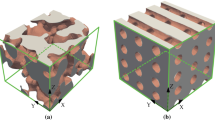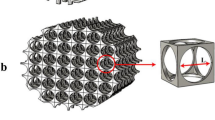Abstract
An interesting application of multi-agent systems (MAS) is in modeling systems that can be represented by independent entities interacting together, the so-called agent-based modeling (ABM). In this paper MAS paradigm is used as a promising technique for representing complex biomedical systems. A brief survey of some ABM of biomedical systems is presented, followed by the description of a multi-layered agent-based framework developed in our own labs to model the process of sprouting angiogenesis (blood vessel formation) within polymeric porous scaffolds used for regenerative medicine. The ABM structure developed and challenges in modeling systems with a large number of rapidly increasing interacting agents are discussed. 2D and 3D case studies are presented to investigate the impact of scaffold pore structure on vessel growth. MAS provides a valuable tool for studying highly complex biological and biomedical systems, and for investigating ways of intervening in such systems.
Access this chapter
Tax calculation will be finalised at checkout
Purchases are for personal use only
Preview
Unable to display preview. Download preview PDF.
Similar content being viewed by others
References
An, G.: In silico experiments of existing and hypothetical cytokine-directed clinical trials using agent-based modeling. Crit. Care Med. 32, 2050–2060 (2004)
Artel, A.: Agent-based techniques in local, autonomous and adaptive decision-making. PhD dissertation: Illinois Institute of Technology (2010)
Artel, A., Mehdizadeh, H., Chiu, Y.-C., Brey, E.M., Cinar, A.: An Agent-Based Model for the Investigation of Neovascularization within Porous Scaffolds. Tissue Eng. Part A 17, 2133–2141 (2011)
Ausk, B.J., Gross, T.S., Srinivasan, S.: An agent based model for real-time signaling induced in osteocytic networks by mechanical stimuli. J. Biomech. 39 (2006)
Autodesk 3ds Max Products: 3D modeling, animation and rendering software, http://usa.autodesk.com/3ds-max/
Brey, E.M., McIntire, L.V., Johnston, C.M., Reece, G.P., Patrick, C.W.: Three-Dimensional, Quantitative Analysis of Desmin and Smooth Muscle Alpha Actin Expression During Angiogenesis. Ann. Biomed. Eng. 32, 1100–1107 (2004)
Brey, E.M., Uriel, S., Greisler, H.P., Patrick Jr., C.W., McIntire, L.V.: Therapeutic Neovascularization: Contributions from Bioengineering. Tissue Engineering 11, 567–584 (2005)
Brown, B.N., Price, I.M., Toapanta, F.R., Dealmeida, D.R., Wiley, C.A., Ross, T.M., Oury, T.D., Vodovotz, Y.: An agent-based model of inflammation and fibrosis following particulate exposure in the lung. Math. Biosci. 231, 186–196 (2011)
Carmeliet, P., Jain, R.K.: Angiogenesis in cancer and other diseases. Nature 14, 249–257 (2000)
Chiu, Y.C., Cheng, M.H., Uriel, S., Brey, E.M.: Materials for Engineering Vascularized Adipose Tissue. J. Tissue Viability 20, 37–48 (2011)
Da-Jun, T., Tang, F., Lee, T., Sarda, D., Krishnan, A., Goryachev, A.B.: Parallel Computing Platform for the Agent-Based Modeling of Multicellular Biological Systems. In: Liew, K.-M., Shen, H., See, S., Cai, W. (eds.) PDCAT 2004. LNCS, vol. 3320, pp. 5–8. Springer, Heidelberg (2004)
Dastani, M., van Riemsdijk, M.B., Winikoff, M.: Rich Goal Types in Agent Programming. In: Proc. of 10th Int. Conf. on Autonomous Agents and Multiagent Systems (AAMAS 2011), pp. 405–412 (2011)
Grant, M.R., Mostov, K.E., Tlsty, T.D., Hunt, C.A.: Simulating properties of in vitro epithelial cell morphogenesis. PLoS Comput. Biol. 2, e129, Epub. (2006)
Hart, P.E., Nilsson, N.J., Raphael, B.: A Formal Basis for the Heuristic Determination of Minimum Cost Paths. IEEE Transactions on Systems Science and Cybernetics 4, 100–107 (1968)
Levine, H.A., Nilsen-Hamilton, M.: Angiogenesis - A biochemical/mathematical perspective. In: Tutorials in Mathematical Biosciences III; Cell Cycle, Proliferation and Cancer, pp. 23–76 (2006)
Liu, G., Qutub, A.A., Vempati, P., Mac Gabhann, F., Popel, A.S.: Module-based multiscale simulation of angiogenesis in skeletal muscle. Theor. Biol. Med. Model. 8 (2011)
Muthukkaruppan, V.R., Kubai, L., Auerbach, R.: Tumor-induced neovascularization in the mouse eye. J. Natl. Cancer Inst. 69, 699–708 (1982)
North, M.J., Collier, N.T., Vos, J.R.: Experiences Creating Three Implementations of the Repast Agent Modeling Toolkit. ACM Transactions on Modeling and Computer Simulation 16, 1–25 (2006)
O’Neil, C.A., Sattenspiel, L.: Agent-based modeling of the spread of the 1918-1919 flu in three Canadian fur trading communities. Am. J. Hum. Biol. 22, 757–767 (2010)
Papavasiliou, G., Cheng, M.H., Brey, E.M.: Strategies for Vascularization of Polymer Scaffolds. J. Investig. Med. 58, 834–844 (2010)
Railsback, S.F., Lytinen, S.L., Jackson, S.K.: Agent-based Simulation Platforms. Review and Development Recommendations Simulation 82, 609–623 (2006)
Repast Home Page: Repast Organization for Architecture and Design, Chicago, IL, http://repast.sourceforge.net/
Rouwkema, J., Rivron, N.C., van Blitterswijk, C.A.: Vascularization in tissue engineering. Trends Biotechnol. 26, 434–441 (2008)
Thorne, B.C., Bailey, A.M., DeSimone, D.W., Peirce, S.M.: Agent-based modeling of multicell morphogenic processes during development. Birth Defects Res. C. Embryo. Today. 81, 344–353 (2007)
Thorne, B.C., Bailey, A.M., Peirce, S.M.: Combining experiments with multi-cell agent-based modeling to study biological tissue patterning. Brief. Bioinform. 8, 245–257 (2007)
van Riemsdijk, M.B., Dastani, M., Winikoff, M.: Goals in agent systems: A unifying framework. In: Proc. of 7th Int. Conf. on Autonomous Agents and Multiagent Systems (AAMAS 2008), pp. 713–720 (2008)
Zhang, L., Chen, L.L., Deisboeck, T.S.: Multi-scale, multi-resolution brain cancer modeling. Math. Comput. Simul. 79, 2021–2035 (2009)
Author information
Authors and Affiliations
Editor information
Editors and Affiliations
Rights and permissions
Copyright information
© 2011 Springer-Verlag Berlin Heidelberg
About this paper
Cite this paper
Mehdizadeh, H., Artel, A., Brey, E.M., Cinar, A. (2011). Multi-Agent Systems for Biomedical Simulation: Modeling Vascularization of Porous Scaffolds. In: Kinny, D., Hsu, J.Yj., Governatori, G., Ghose, A.K. (eds) Agents in Principle, Agents in Practice. PRIMA 2011. Lecture Notes in Computer Science(), vol 7047. Springer, Berlin, Heidelberg. https://doi.org/10.1007/978-3-642-25044-6_11
Download citation
DOI: https://doi.org/10.1007/978-3-642-25044-6_11
Publisher Name: Springer, Berlin, Heidelberg
Print ISBN: 978-3-642-25043-9
Online ISBN: 978-3-642-25044-6
eBook Packages: Computer ScienceComputer Science (R0)




